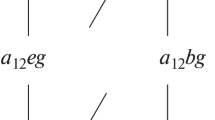Abstract
The property of the functionality of the causal relationship (a subobject is the cause of multiple properties) used in the JSM method for the automatic generation of hypotheses is considered. The functionality of this relationship on each fixed step of the JSM reasoning is shown. Some features of the studied characteristics of the causal relationship on sequences of JSM reasoning steps are examined.
Similar content being viewed by others
References
Finn, V.K., The inductive J.S. Mills methods in artificial intelligence systems, Iskusst. Intell. Prin. Resh. Part I, 2010, no. 3, pp. 3–21; Part II, 2010, no. 4, pp. 14–40.
Avtomaticheskoe porozhdenie gipotez v intellektual’nykh sistemakh (Automatic Generation of Hypotheses in Intellectual Systems) Finn, V.K., Ed., Moscow: Librokom, 2009.
Zabezhailo, M.I., Non-hereditability of empirical contradiction in JSM-method and nonmonotonic argumentations, Nauchn.-Tekhn. Inform., Ser.2, 1984, no. 11, pp. 14–17.
Author information
Authors and Affiliations
Corresponding author
Additional information
Original Russian Text © M.I. Zabezhailo, 2013, published in Nauchno-Tekhnicheskaya Informatsiya, Seriya 2, 2013, No. 7, pp. 33–38.
About this article
Cite this article
Zabezhailo, M.I. On the functionality of the causal relationship used in JSM reasoning. Autom. Doc. Math. Linguist. 47, 162–167 (2013). https://doi.org/10.3103/S0005105513040079
Received:
Published:
Issue Date:
DOI: https://doi.org/10.3103/S0005105513040079



